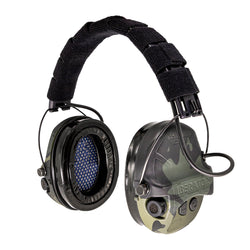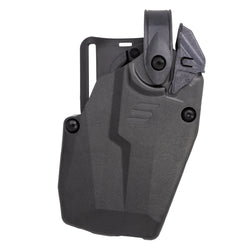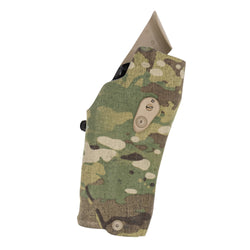The Safariland SAVES program isn’t just a list of names—it’s a testament to lives protected and second chances granted. Each member has a story, a moment when the right gear made all the difference. This series introduces you to those stories.
The Safariland SAVES Club® highlights individuals who put their lives on the line in the line of duty and, in turn, had their lives saved by their gear. In this installment, we meet Sgt. James “Buddy” Brown, who owes his life to his Safariland® PROTECH Delta 4 ballistics helmet.
BACKGROUND
Sgt. James “Buddy” Brown began his law enforcement career around 2000. By the time of his SAVE in January 2018, he had nearly 18 years with the York County Sheriff’s Office in South Carolina, including 13 years on the SWAT team.
THE CALL
On the cold night of January 15, 2018, York County received a domestic violence call involving alcohol. A woman reported that her husband became violent after she poured his alcohol down the sink. While still on the line, dispatchers could hea hear him assaulting his wife.
According to Buddy, the incident took place in a nice middle-class neighborhood with larger lots, about an acre or so each. When the first units arrived, they learned the suspect had fled into a wooded area behind the home, carrying a go-bag and a rifle.
Additional resources were called to the scene, including a K-9 and handler, to help track the suspect. Because the suspect was known to be armed and potentially suicidal, a trailing team was assigned to assist with the track.

Buddy initially called in to assist, but was told to sit tight and stay dressed just in case. The K-9 team entered the field around 10:30-11:30 pm and followed the suspect’s track. A SLED helicopter unit also reported to the scene and was tracking the suspect using heat signature technology.
A short while into their track, the suspect opened fire on the K-9 team, wounding the handler in the leg. After a brief exchange of gunfire, the suspect ran off. The K-9 handler was evacuated to the hospital, leaving two officers in the field with the helicopter to continue to track the suspect. During this time, the helicopter received gunfire from the suspect. The first exchange of gunfire triggered a full SWAT response — code 3 to the command post — including deployment of the unit’s BearCat vehicle.
The original plan was to have the SWAT officers load into the BearCat, keep close to the suspect, and apprehend him. The SLED had tracked the suspect after the shooting and still had eyes on him.
Unfortunately, soon after SWAT arrived at the command post, the helicopter had to leave the scene due to dangerously low fuel levels. It was in such bad shape that it had to land in a nearby Walmart parking lot, unable to reach the airport. That’s when a bullet hole was discovered in the tail section. Buddy fully believs the helicopter crew saved lives by staying on scene as long as they did.
Going into the field without SLED support wasn’t ideal, but Buddy and the rest of the SWAT team moved to the suspect’s last known location. Buddy recalls entering the field, looking around, and realizing that not everyone had a full set of protective gear
Even with all the spotting tools at their disposal, SWAT was unable to locate the suspect. York County worked with Charlotte-Mecklenburg officials, who deployed their own helicopter. However, the two agencies faced communication issues due to incompatible radio channels. After additional searching, the SWAT team in the BearCat returned to the command post.

At command, a report from the Charlotte-Mecklenburg helicopter showed a heat signature from a John boat, or skiff, behind a house a little way down the road. SWAT was ordered to deploy to that location to investigate. The BearCat pulled into the driveway. As Buddy explains, houses in that area use septic tanks, and the team didn’t want to do any damage to the yard if the suspect wasn’t there.
The team decided to split — Buddy’s group going left, the other going right around the house — to meet at the rear near the boat. As the first team moved out, they took the opposite direction. Using night vision, Buddy’s team hugged the tree line to avoid stepping on dry leaves and giving away their position.
Buddy noticed the ground started to drop off behind the house when he spotted some space under the rear deck. He didn’t think it was large enough for a man, but raised his left hand to motion for someone to check under the deck — just in case.
Shots rang out from under the deck, hitting Buddy and another SWAT member. Buddy was struck three times—once on the handguard of his rifle, once on his Safariland® ballistic helmet, and once in his left hip. He knew he’d been hit in the hip but hadn’t realized he’d taken a round to the helmet. He rolled into the tree line and returned fire toward the suspect, using his weapon light to illuminate the target for his team.
During the exchange, the second SWAT team rounded the corner and saw the gunfight unfolding. It was around 3 a.m., and in the confusion, they couldn’t immediately tell who was SWAT and who was the suspect. To complicate things further, Buddy had ended up near the John boat, which they originally believed was giving cover to the suspect.
Once the gunfire stopped, the second team was able to identify Buddy and take the wounded suspect into custody. The SWAT team also had armed medics, and thanks to these men, they were able to treat the wounded at the scene.
Three SWAT members were hurt at the scene, including Buddy. Sadly, Detective Mike Doty was fatally wounded by the suspect. Buddy was treated at the scene, including having a tourniquet applied to his leg. Sgt. Kyle Cummings was also injured, and Buddy said Kyle’s life was saved by a well-placed tourniquet for femoral bleeding.
Buddy noted another team on site assisted with treatment and evacuation. Since they were from a different unit, their gear was unfamiliar—while trying to remove Buddy’s vest, they accidentally hit him in the face with it. He joked that he’s not a small guy, and the team struggled to carry him, dropping him a few times. After the last drop, he offered to jump into the truck himself.
Both Buddy and Kyle were evacuated safely. Buddy was suffering from internal bleeding, causing swelling in his leg and abdomen, along with a gash on his forehead. All three injured officers were transported to Charlotte-Mecklenburg Trauma Center by air and ground ambulance.
Upon arrival, hospital protocols ensured the suspect and officers never crossed paths. Staff weren’t informed who was who, so everyone received equal care. It was at the hospital that Buddy finally realized how badly he was hurt when he caught a glimpse of himself in a window.
Buddy was slated to go right into surgery for his injuries, but thankfully saw his girlfriend Veronica before being wheeled in. The surgery was a long one, with the best vascular surgeon on the East Coast in attendance, saving Buddy’s leg. He later learned he’d received an astronomical 12 units of blood during the surgery.

RECOVERY & LIFE AFTER
Buddy spent 10 days in the hospital recovering from his injuries. While still in the hospital, he was able to attend the funeral of fellow SWAT member Det. Doty, albeit confined to a wheelchair and dressed to cover all his wounds.
Once released from the hospital, he was sent home to recover as best he could. Home health aides assisted with physical therapy and helped him relearn how to walk. It was after one of those sessions that his persistent nausea and dizziness were finally addressed. The cut on his forehead hadn’t received much attention compared to his other injuries; Buddy assumed it came from his night vision mount or during the chaotic moments of being loaded into the truck. It wasn’t until days later — after his helmet was found with a large dent — that the true cause became clear.
Buddy is very candid about the PTSD that came from the event, including the overwhelming survivor’s guilt. During an interview, he noted that not all SWAT members were as fully equipped as they perhaps should have been. Due to the severity of his head injury, Buddy was enrolled in a cognitive rehabilitation program as part of the process of healing from all the injuries sustained from the call.
After the incident investigation was completed, Buddy was medically retired from SWAT, though he stays active in law enforcement. He now works in the firearms lab for York County and speaks regularly about the incident, his recovery, and how others can navigate similar situations.









